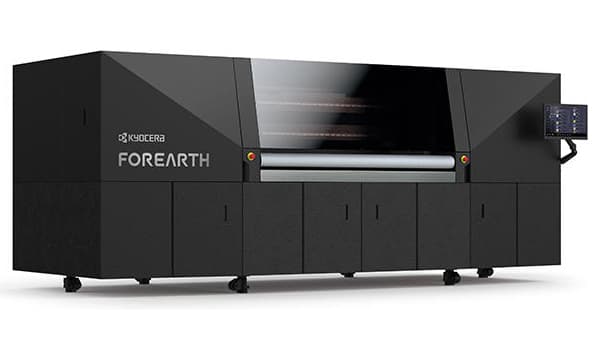Japanese multinational Kyocera Corporation has launched FOREARTH, its new inkjet textile printer that aims to eliminate virtually all water usage from fabric printing, and printing-related water pollution that has been an issue faced by the textile and apparel industries worldwide.
Compared to traditional analog printing systems that consume large amounts of water, especially in washing and steaming processes, and waste water pollution due to fabric printing, Kyocera’s aptly-named FOREARTH combines patented inkjet, ink, and printing equipment technology to contribute to solving these environmental problems.
FOREARTH is an All-in-One printing system that uses new proprietary pigment ink, pre-treatment liquid, and finishing agent, which are constantly discharged in the same sequence from the inkjet head. This system eliminates the pre- and post-processes required for conventional dye printing and dramatically reduces water consumption of textile printing by 99%. According to Kyocera, the new process uses only 0.02 litres of water per kilo of fabric as compared to 153 litres per kilo used in traditional dye-based textile printing process. Energy consumption and CO2 emissions are also reduced as it does not need large-scale equipment used for pre- and post-treatment processes of textile printing.
Kyocera’s proprietary ink technology solves the typical problems of pigment printing, such as less colour development, fastness, and hard hand-feel. In contrast to the conventional dye digital printing that generally requires different types of dyes for different fabrics, FOREARTH’s All-in-One printing system enables highly detailed printing on diverse fabrics ranging from cotton, nylon, polyester to silk and blended fabrics with a single machine. It is also adaptable to a wide range of categories, from babywear and home textiles to ladies’ fashion and sportswear.
With a maximum of eight colours (CMYK+4 special colours) and 18 printheads, the machine has a print resolution of 600×600 dpi and a standard print speed of 250 m2/h.
FOREARTH brings immense flexibility into production. While textile dyeing factories are generally operated in areas with abundant water resources since the printing process requires large amounts of water, production sites using FOREARTH can be located anywhere, such as on-shore, near-shore, or in more suitable areas such as those located closer to consumers, as it needs only a small amount of water for printing.
The new textile printer’s simple two-step printing and drying system drastically shortens the number of steps from design to production. As a result of this streamlined processing, FOREARTH supports optimized production and location settings and therefore can handle small-lot printing and shorten delivery times, helping reduce logistic costs and surplus inventories. Moreover it can complete print production within a small area footprint compared to conventional textile printing, which requires many more printing processes with separate equipment.
